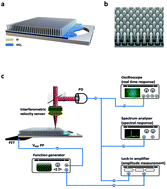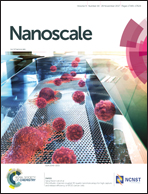Probing the chaotic boundary of a membrane resonator with nanowire arrays†
Abstract
Mechanically induced nonlinearities in nano-electromechanical systems (NEMSs) are typically avoided in design due to their unpredictable nature; however, by incorporating these normally unwanted nonlinear and chaotic phenomena, the performance of NEMS devices displays substantially different characteristics opening a broad new range of potential applications for their use. In this work, experiments have been conducted for probing the chaotic boundary of a circular membrane mechanical resonator with and without a silicone nanowire array (Si NWA). The NWA resonator can transition from linear to nonlinear quasi-periodic behaviour, and further transition into a chaotic state at resonance. Moreover, the NWA resonator demonstrated a high level of complex nonlinear behaviours, as the device expands the power spectral response from a single frequency at a linear regime to a wideband continuous frequency spectrum when chaotic behaviour was initiated; the threshold power of this transition decreased with a smaller NWA diameter. It was also observed that the NWA resonator had higher damping compared to the resonator without a NWA; however, as the vibration velocity of the NWA resonator increased, complex air damping and thin squeeze film damping lowered the threshold for probing the chaotic boundary condition of the NWA resonator.



 Please wait while we load your content...
Please wait while we load your content...